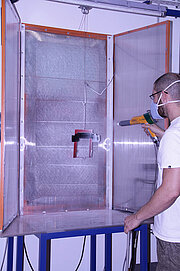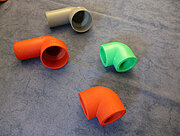Powder coating has very many advantages over other coating processes: Compared with classic liquid coating for example, it does not require the use of solvents. To date however, only products that conduct electricity could be powder coated – for plastics the option was therefore not available. Jointly with the Offenburg University of Applied Sciences, the firm Schneider Oberflaechentechnik based in Lahr, Germany, developed an entirely novel process which allows powder coating of plastics and plastic composites. The Technologie-Lizenz-Buero (TLB) GmbH supports the protection of the intellectual property and manages the commercialisation process. The trade journal „Besser Lackieren“ (Better Painting) has reported on this technology on a number of occasions. The current edition of the journal carries an interview with the CEO of the company Schneider Oberflaechentechnik, Mr. Harald Schneider (http://www.vincentz.net/dl.php?fid=48701a04-7bb3-1031-954b-00163e9dbcaa).
The newly developed powder coating process opens up entirely new markets because it makes it possible to use the technology on plastics which, compared to metals, are not conducting and less temperature resistant. In future therefore, it will be possible to powder coat all common thermoplastics such as PVC, polyamides and ABS. This may make the world of kitchen and household appliances much more colorful. Possibilities will also open up in the automobile as well as in the furniture industry and garden design.
The enterprise Schneider Oberflaechentechnik has specialized for many years in powder coating and liquid varnishing. The classic electrostatic powder coating has so far been used extensively for the coating of products that are electrically conductive, in particular metallic objects and products made of oxidation sensitive steel or aluminium. The most common and cost competitive powder coating products consist of minuscule particles (approximately 1 – 100 µm) of epoxy or polyester resins as well as hybrid materials. In this process, the small paint particles are being electrically charged and are transported onto the metallic work piece via electrostatic forces and subsequently melted into a coating by the application of heat. So far the limitations were insurmountable in the cases where the work piece was not or only in a minor way conducting electricity, such as pieces of plastics or plastic composites. In these situations, not sufficient quantities of the paint particles are deposited on the object due to the weak electrostatic forces and the result is a coating of insufficient thickness.
In a collaboration between Professor Johannes Vinke from the Offenburg University of Applied Sciences and the CEO Harald Schneider, the idea to apply the power coating process to standard plastics was developed. In a cooperative research project, they tested methods which may be used to prepare standard thermoplastics used in technical and consumer applications for powder coating. „We were looking for a novel and efficient option which in addition could be easily integrated into existing production processes“, explains Professor Vinke who teaches and carries out research in mechanical and material engineering at the Offenburg University. The main focus of the research was the development of a permanent primer which would be effective without the inclusion of conducting, most commonly metallic, additives. High quality, stability and durability of the powder coating on the object were the essential criteria for Harald Schneider.
The project was undertaken within the framework of a ZIM-support program of the Federal Ministry of Economy and Technology (BMWi). ZIM stands for „Zentrales Innovationsprogramm Mittelstand“, which means central innovation program for SMEs. The ZIM-Program is aimed at strengthening the innovative capacity and competitiveness of enterprises, including trades and independent entrepreneurial positions, in a sustainable manner and thereby to contribute to economic growth combined with the creation and maintenance of jobs. The Technologie-Lizenz-Buero (TLB) GmbH provides support in applying for protection of the intellectual property underpinning the process which had been developed.
Harald Schneider, owner of the firm of the same name based in Lahr, is ecstatic about the new process: „The fascinating thing is that we can now apply our primer on the cleaned plastic surface with no need for a conducting additive. And subsequently, we can apply the power coating electrostatically using standard application processes and then apply heat to melt the particles into a solid coat of paint.“ The enterprise Schneider Oberflächentechnik is already in a position to offer the novel process to the market. Harald Schneider is in discussion with a number of customers. „We have achieved good results, particularly with injection molded products and with material that is temperature resistant“, comments Harald Schneider. „We can now even powder coat in three dimensions. And the result is really extremely good!“ Schneider built a small prototype installation which he uses for trials and tests. He is now looking for customers to collaborate with in small projects and small serial productions to demonstrate the quality of the coating on products. „We have to gain experience. The famous final polish can only be achieved on the actual product.“

![[Translate to english:] Das neue Verfahren ermöglicht die Pulverlackbeschichtung auch bei Kunststoffen. Damit kann die Welt der Küchen- und Haushaltsgeräte bald viel bunter ausfallen. Auch in der Automobilindustrie, bei Möbeln und in der Gartengestaltung werden dadurch viele Möglichkeiten eröffnet. [Translate to english:] Das neue Verfahren ermöglicht die Pulverlackbeschichtung auch bei Kunststoffen.](/fileadmin/_processed_/c/c/csm_Kochtopfgriffe_9f3e933197.jpg)


